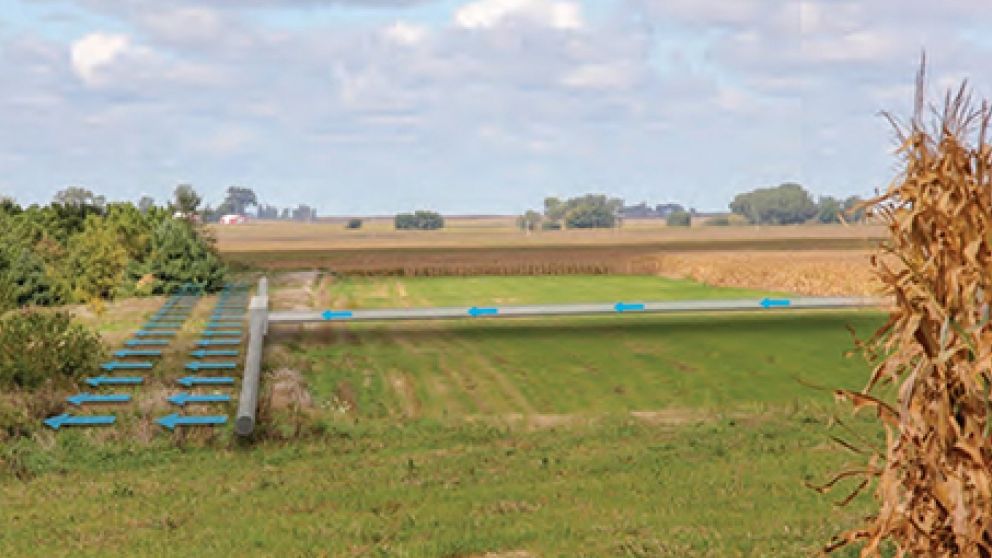Revisiting the Roadman’s

Ever since John and Lusetta Roadman settled into their Grundy County Iowa farm in the 19th century, the family has put a special emphasis on being good stewards of the land. Today, that legacy continues with Keene and Christian Roadman (John and Lusetta’s great-great-grandsons), as they have taken ownership and responsibility for the farm.
Saturated Buffers
In 2016 and 2017 Keene and Christian Roadman along with their farm manager Morgan Troendle, partnered with Dan Jaynes with USDA, Tall Grass Prairie Center at the University of Northern Iowa and Iowa State University (ISU) in piloting some conservation research programs. The Saturated Buffer program they implemented has proved to be worthwhile for the Roadmans.
With tile drainage, excess nitrates and phosphates can sometimes be carried off the fields into ditches, streams, and rivers, especially in early spring after the first major rain event. While these nutrients are a natural part of aquatic ecosystems, too much entering the environment at once can have negative effects such as excessive algae growth. One possible solution to this issue is utilizing saturated buffers.
According to the United States Department of Agriculture (USDA), a saturated buffer is a subsurface perforated distribution tile used to divert and spread drainage system discharge to a vegetated area. By utilizing saturated buffers, a portion of the drainage water is diverted into lateral drainage tile installed along the buffer. This helps to increase shallow groundwater level and provide effective nutrient removal. Essentially, it diverts flow into a buffer of growing plant/ tree root systems that absorbs nutrients before they can enter streams and other water sources.
The Roadman’s had a saturated buffer installed on their farm, and the data shows the buffers have been well worth it for the family.
Continued Improvement

Figure 1 shows the results of the Roadman saturated buffer near Dike, Iowa for 2017. The graph shows the flow rate (solid line) in the field tile as it is entering our control box located in the buffer. This site tends to flow most of the year even though the 2nd half of 2017 was dry statewide. The green diamonds are the nitrate concentration within the adjacent creek on the days USDA representatives visited the site. These concentrations ranged from about 2 to 14 mg-N/L of nitrate. The gold squares are the nitrate concentrations in the field outlet. They were very similar to the concentrations in the stream except during July and August when stream nitrates were low due to in-stream nitrate removal processes (algae growth etc.).
“The information shows what we would expect, the nitrate levels are equal to or slightly higher than stream levels due to the direct route the water travels through the tile to the stream,” explains Farm Manager Morgan Troendle. “With 10 mg nitrate level being the standard threshold for drinking water safety, the ideal levels would be below this on a long-term average. That’s where the next graph of results help to show the benefit of the buffer.”

Figure 2 shows the cumulative pounds of nitrate that were in the field tile drain (blue line), the amount of this nitrate that was diverted into the buffer by the control structure (green line), and the pounds of nitrate that were removed in the saturated buffer (gold line). At this site, about 80% of the nitrate from the field tile was diverted into the buffer and almost all (98%) of this nitrate was removed in the saturated buffer. The total nitrate removed was 378 pounds of N. This is nitrate that would have otherwise discharged into the stream. Undoubtedly, the saturated buffer also removed nitrate before measuring flow began in June, but the amount was notable to be measured.
This information shows that the water diverted into the buffer enters the stream with a much lower average nitrate concentration which in turn, contributes to reducing the stream’s overall concentration to a more reasonable level on average. Essentially, the saturated buffers are working exactly the way they are supposed to, not solving the entire problem but helping to make a small reduction which when combined with additional conservation efforts from others, helps to improve water quality incrementally.
Valuable Partnerships
In addition to conservation improvements, there have also been valuable new partnerships that have come out of the conservation projects, including new opportunities for continued education for other landowners.
“The individuals and organizations involved in these projects have all brought a unique specialty, skill, or asset to the table to provide real results. The relationships built through the project have opened opportunities for additional projects and partnerships to help expand the network of data and educational opportunities for other landowners who are interested in making conservation improvements on their farms.”
“Our greatest enjoyment has been in the relationships built and the concrete, measurable results we have seen as a result of these partnerships,” says Larry Roadman on the overall experience the last few years.
Posted By Hertz Farm Management on August 9, 2018





